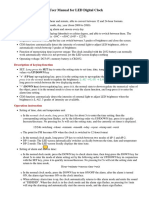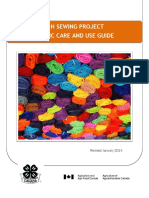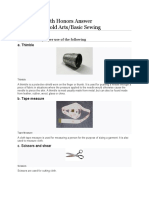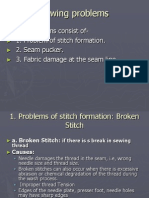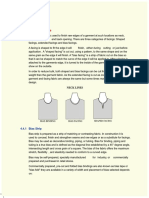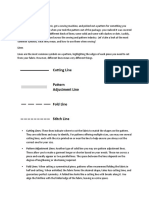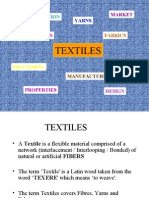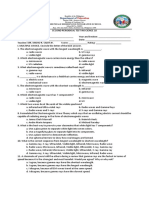Sewing Threads From Polyester Staple Fibre
Uploaded by
ganeshaniitdSewing Threads From Polyester Staple Fibre
Uploaded by
ganeshaniitdSewing Threads from Polyester Staple Fibre
V.Thanabal, Assistant Professor (Sr.Grade)
Introduction
Advantages of spun sewing threads includes excellent lubricity provided by the surface hairs, ability to form a variety of stitches, economical greater seam strength and elasticity combined with high elongation and applicable to a variety of fabrics Cotton sewing threads were most widely used in the past. Increasing usage of synthetic and blended fabric reduces the use of cotton sewing threads and the use of synthetics is in increasing trend. Of this polyester is one of the major fibers. Since single yarns are characterized by the problem of unbalanced torque (resistance to twist) creating snarls making twisting difficult. As a result single threads were plied together and twisted together to balance the unbalanced twist in the single yarns. Spun threads generally have good stability and holding power. Compared to cotton sewing threads, polyester yarns do not require singeing, Fibres used Polyester fibers meant fro the production of sewing threads do not have delustring agent which is normally added to the fibers for smooth mechanical processing. Since most of the polyester fibers yarns are dyed in the form of packages. Table 1.Fibre properties Fibre fineness Luster Tenacity Elongation Crimps Dry Heat Shrinkage at 196C 30 minutes Finish% Denier gpd % per cm % % 1.2 Bright 7.5 +/-0.4 19.5 3.6 to 4.4 5 0.145+/- 0.015 1.4 Optical White 7.5 +/-0.4 3.6 to 4.4 5 0.145+/- 0.015
Production process
The production process is the same that is followed for normal yarn production However in ring spinning, spindles are rotating n the reverse direction compared to normal yarn to provide reverse twist After plying and twist setting of these yarns will be done to reduce the snarling tendency.
Spinning and plying
Dyeing of spun yarn sewing threads
The packages after ply twisting s taken to dyeing section for colouration The process flow during the dyeing process is given in the chart. In dyeing section the following are factors which influence the good performance of yarn and a better dyeing 1. Use of damaged spindle 2. High pressure packages 3. Poor condition of inserts The soft wound packages are loaded on the spindles of the dyeing machines by means of the loading mechanism. The loaded spindles are taken to the dyeing vessel. Dyeing takes place in side the dyeing machines Following are the precautions to be taken before the commencement of dyeing.
1. Correct selection of recipe for the shade to be dyed Correct selection of dyeing programme in the machine 2. Weight of recipe must be exact 3. Good mechanical condition of dyeing vessel free from leakage of water and steam
Shade checking after dyeing
A sample dyed yarn is taken from the dyed material and checked against the standard shade card after drying. Any difference in the shade will be corrected by approximate addition r stripping action. For any addition process, the dyed material will once again load to the dyeing vessel and correction will be made. Once a satisfactory or a required coloring is done the wet dyed packages are taken to hydro extraction for the removal excess water in the packages. After hydro extraction the residual moisture is removed by means of drying. Drying s carried out either by hot air drying or by radio frequency dryers. After drying winding is done on cone packages. These packages are converted to small packages of different length and different shape.
Different types of packages
Quality Assessment for sewing threads Thread Count
Count or number of sewing thread is in general measured by the ASTM test method designated D-1059 for short-length specimen and skein method (ASTM-1907) for long specimen length. The direct system of thread number is based on measuring the weight per unit length of a yarn, where as the indirect system is based upon the length per unit weight of a thread. In the short-length method, the specimens of prescribed length, usually 1m or less, are cut from a conditioned sample, which is under prescribed tension, and weighed. For skein method, the specified lengths of thread are wound on reels as skeins, and weighed. The count or thread number is then computed from the mass and length of thread.
Thread Diameter
The diameter of sewing thread is an important parameter for effective sewability. It must be appropriate to the size of the needle eye. If the thread diameter does not match with the size of the needle eye, the thread may break during sewing deteriorating the appearance of the seam. When the diameter of the thread is large enough, it displaces the yarn in a fabric, resulting seam puckering. Generally the width of the needle eye is about 40% of the size of the needle. Sewing thread must not occupy more than 60% of the width of the eye to avoid the fraying of thread during sewing. Sewing thread diameter is also a consideration in selecting sewing thread for embroidery,
contrast stitching, or other decorative applications, since cover is important with such threads. So, diameter of a sewing thread is an important parameter to measure.
Thickness gauge method
A thickness gauge with standard pressure foot diameter (9.52+0.02mm) is used. The pressure foot and other connected moving parts shall be weighted to apply a total force of 1.67+0.03N equivalent to a pressure of 23.4 kPa For measuring the diameter, the thread is to be drawn from the side of the holder without disturbing the twist. Then four such strands of the thread are to be placed side by side on the anvil and approximately mid-way between the sides of the pressure foot of the thickness gauge. Then, the thickness to the nearest 0.02mm is to be measured and to be recorded as the diameter of the thread. The next reading is to be taken after removing at least 300mm of thread from the holder and 10such readings to be taken along the length of the threads to calculate the average diameter of the sewing thread.
Optical method
In this method, a microscope, having a stage that can be rotated to bring the thread parallel to the movable cross hair in the eyepiece, is used to measure the diameter of the threads. The mounting plate, with clip or other means is used for holding the thread at a constant tension sufficient to remove any slackness in the thread without stretching it. Before measuring the diameter, the thread is drawn from the side of the holder without disturbing the twist. Then the thread is to be mounted on the movable stage of the microscope using the mounting plate and the stage is rotated until the thread is parallel ti the movable cross hair. The diameter of the thread is measured to the nearest 0.02mm, as the difference in the micrometer settings when the cross hair is moved from the one edge of the thread to the other. The next reading is taken after removing atleast 300mm of thread from the holder and 20 such readings to be taken along the length of the thread to calculate the average diameter of the sewing thread.
Shrinkage
Measurement of shrinkage of sewing thread is very important because it may cause puckering along seams and thus adversely affect the seam appearance. The following combinations may change the influence of sewing thread shrinkage on the seam: the construction and mass of the seamed fabric, the nature of the seam assembly, or the tension on the sewing thread during sewing. Shrinkage testing of thread due to its exposure to dry heat and boiling water
Dry Heat Shrinkage
After preheating the drying oven to 176+3oc, the specimen is suspended freely from a stationary rack side the oven away from the side walls. After the oven returns to the original temperature, the specimen is then exposed for 30+2min. Then the specimen is removed, conditioned and the loop length is measured.
Boiling Water Shrinkage
The specimen is wrapped in cheese-cloth. The wrapped specimen is immersed in boiling water and allowed to boil for 30+2min and then the cheese cloth along with the specimen is removed from the bath. The excess water is squeezed out from the cheese cloth and the specimen is then removed from the cheese cloth and dried in a drying oven at 65oc for 1hr and conditioned. The loop length is then measured.
Determination of residual Shrinkage
Apparatus used - Mounting Device.The device shall be such that a test specimen of at least 100cm length can be mounted on it, with one of its ends in a fixed clamp under the desired dead weight tension. a. Exposed to a temperature of 150c or 180c b. Immersed in water at 100c The shrinkage of each test sample is to be calculated using the following equation; Shrinkage% = I1-I2 / I1 X 100 Where, I1 = original length of the loop I2 =length of loop after exposure
Package Length
Measurement of length per package is very important because the sewing thread is sold on length basis. This test method is used to measure the total length of thread in a package. The length of thread on a package is measured by winding the thread from the package to a reel of known perimeter into skeins. The total length is measured by counting the number of complete skeins of specified length, number of wraps in last partial and by measuring the length of the last partial wrap. Length of thread in the package=I1+I2+I3+I4+ . . . . . . . . + I n
Hairiness
The hairiness of sewing thread is an important property for its effective and efficient performance during sewing. Too high hairiness of thread restricts its smooth run through the needle eye and other thread path of a sewing machine resulting in thread breakage, high heat generation or many other defects in seam. Measurement of hairiness is important for sewing thread made out of staple fibers. Hairiness is defined as the tendency for component fibers to stand out from the surface of the yarn into the surrounding air. Hairiness of yarn or thread is commonly measured optically in two different methods. In one of the method the overall length of the hair present in unit length of yarn is measured. And in another method the number of hair protruding above certain lengths are counted. The hair are classified in a number of classes.
Friction Coefficient
Frictional property plays very important role for effective sewability of a sewing thread. A A controlled level of both static and kinetic friction is required; the frictional force should not be too high, which could cause thread breakage, and not too low, which could cause improper thread control and seam slippage. In its simplest form as illustrated the yarn is merely hung over the rod, so that it becomes () radians. In that case the equation becomes:
Where, = coefficient of friction, 1n = natural logarithm, to base e (2.718) T1 = mean input tension T2 = mean output tension, and Q = wrap angle, 3.14radian Lawson Hemphills Constant Tension Transport(CTT) is an instrument which can be used for testing of yarn to metal/ ceramic or yarn to yarn friction. The thread withdrawal at constant tension is utilized here to measure the friction coefficient applying capstan method. With the precisely controlled input tension, thread drag over the standard pins or on itself is monitored with a tension meter in thread path to calculate coefficient of friction.
Unevenness and Imperfections
Unevenness is a degree of uniformity of a sewing thread either in terms of mass per unit length or in terms of diameter. Sewing performance can be affected by unevenness of yarn because 7
the thread is required to pass smoothly through the needle eye and tension disks. More uniform the thread is better is a sewing performance thus resulting in better seam quality. Unevenness of yarn is generally measured by two different testers i.e. instrument having capacitance type sensor and the instrument having photoelectric type sensor. Unevenness in terms of mass per unit length is measured by capacitance type tester and diameter irregularity is measured by photoelectric type tester. However he variation in diameter is more useful for characterizing the uniformity in the sewing thread, because the actual diameter of a particular portion of a sewing thread is important for effective sewing performance and uniform seam quality. The imperfections such as thin place, thick place, and neps are also measured by unevenness tester. Details of testing parameters, setting etc. Vary with the type of instrument. However it is common that testing is performed almost in every yarn manufacturing unit.
Strength and Elongation
Measurement of strength and elongation is very important because the loop properties, the most important characteristics of a sewing thread, are strongly dependent on tensile strength and elongation. Also the performance of seam is very much dependent on the tensile strength and elongation properties of a sewing thread. The tensile properties of almost all types of sewing thread can be measured by any of the following principles. Any single strand tensile testing machine working on one of the following principles, can be used: Constant rate of loading Constant rate of extension Some testing instruments based on CRE principle, has the provision of moving the top jaw in order to operate the load-indicating mechanism. The movement of top jaw relative to movement of bottom jaw prevents the extension of sample at an absolutely constant rate. The fact is that bottom jaw traverses downwards at a constant rate and that is why such tensile testing machines are referred to as constant rate of traverse testers.
Loop strength and knot strength
The loop breaking strength is measured to assess the ability of a sewing thread to contribute to seam performance. It bears a direct relationship to stitch breaking strength and hence to seam breaking strength. The loop elongation of a sewing thread is also one important parameter contributing to elongation of a seam, along with the stitch and seam type, the number of stitches per inch, and the nature of material stitched. The knot strength of a sewing thread is considered a measure of the brittleness of the thread. 8
Reduction in knot strength reflects the performance of a thread after stitching. The thread, after proper conditioning is withdrawn from the thread holder very carefully to avoid any change in twist or any stretching of the specimen. For measuring loop strength and elongation, two pieces of a thread are taken from one thread holder or end. Then both ends of one piece are fixed in one clamp of a tensile testing instrument without a change in twist. The length of the loop is approximately one half the gauge length. One end of the second piece is then passed through the loop formed by first piece and both the ends of a second piece are fixed in the other clamp of the machine. The loop breaking strength and elongation is then measured in the same way as that of tensile strength and elongation.
Abrasion Resistance
A sewing thread is subjected to vigorous abrasion during sewing operation while it moves through needle eye and different parts of a sewing machine. In a garment or any other finished goods the sewing threads need to withstand a great deal of abrasion while in use. Abrasion resistance of sewing thread is thus very important quality parameter of a sewing thread. There are different methods available for assessment of abrasion resistance. Before testing, the sewing thread is conditioned in standard atmosphere condition. In Sweigle Abrasion Tester, an appropriate grade emery paper and pretension weights are used and the results are recorded as the number of strokes required to break the specimen as calculated. The average value of number of strokes required to break the specimen. The average value of number of strokes are then converted in terms of Relative Resistance Index. In this rubbing method the interpretation of abrasion data is some what difficult. While some yarns may break after few strokes, others may endure higher number of
strokes. The suggested formula for relative index is Apart from the above method, measuring the reduction in weight or strength of samples after subjecting a thread to a definite amount or rubbing, is also a measure of abrasion
UV Resistance
Ultra-violet rays are a part of spectrums of electro-magnetic radiation emitted by sun. They severely damage the thread if exposed continuously for long periods.
Effect of sun light
Base polymer of sewing thread is irradiated by ultraviolet/visible light. And this results in 9
change in the physical and chemical properties of polymer of sewing thread due to absorption of energy. This energy absorption promotes the degradation of the polymeric chain and ultimately the strength loss to the sewing thread. Not only this, UV radiations also attack the dyes present thread leading to spotting and fading of color of sewing thread. Though, UV degradation of thread takes place at different rates depending upon the type of polymer of which thread is made of. Such degradation does not happen at a time. UV impacts the thread life by gradually deteriorating its strength. There are several factors that can be made accountable for UV degradation of sewing thread.
Chemical Properties
Testing of some important chemical properties are briefed here; 1. Color fastness to washing 2. Color fastness to dry cleaning 3. Color fastness to water migration 4. Color matching
Colour Fastness to Washing
Use of colored sewing thread is a very common practice. The colored sewing thread is used either as per matching with the color of fabric or some with a contrasting color for some special effects. If the color fastness of sewing thread to washing is not up to the mark, then the sewing thread may spoil the garment by color bleeding. The alteration in shade and staining by sewing thread under conditions similar to that experienced in domestic washing of apparel and other textile end products is determined. The thread, under test, is laundered in contact with a multi fibre test cloth with the help of home laundry and drying equipment. The laundering can be done with or without bleach, depending on the conditions one tries to reproduce the effect of home laundering on sewing thread. The change in shade of the sewing thread and the degree of staining of the multi fibre test cloth are graded with the help of standard Grey scale. Three parallel lines are stitched on a 50mm square multi fibre test fabric using thread from a thread holder. The direction of stitch should be perpendicular to the strips and completely across the multi fibre fabric. The stitch density is normally kept at 8 stitches per inch and stitch lines are placed approximately 10mm apart and the first line starts about 15mm from the edge of test fabric.
Colour Fastness To Dry Cleaning
Delicate stitched materials are normally dry cleaned. It is important that he sewing thread should retain its color or does not stain the adjacent fabric during. Alteration in shade and of staining by sewing thread dry cleaning is determined by this test method.
10
A 50mm square multifibre test fabric is stitched with a sewing thread in a similar way as described earlier. Then the specimen is dry cleaned as per the procedure under test method ASTM D2724. The alteration in shade of sewing thread and the degree of staining of the multifibre test cloth after dry cleaning is then graded as per standard procedure.
Colour Fastness TO Water Migration
Color fastness to water migration of a sewing thread is very important so that color doesnt create staining of the garment or any finished product through water migration. Level of staining by a sewing thread under home care conditions similar to those experienced when items are left in a wet condition for a specific period of time is measured by this test method. A 50mm square multifibre test fabric is sewn with three parallel lines of stitching space 10mm apart with the first line 15mm from the test fabric edge. Using the sewing thread to be tested. Generally the stitch length is 8 stitches per inch. Then the standard polyester/cotton terry cloth is cut with 50mm *150mm dimension. The specimen and strips of terry cloth are then home laundered as per the standard method mentioned in AATCC test method 143. The specimen is then rolled in the terry cloth strip and inserted into a test tube. The test tube is then allowed to stand for 4hr at ambient temperature. After 4hr the specimen is then removed from test tube and graded immediately for change in degree of staining.
Colour Matching
Matching of colors of a sewing thread and piece goods is very important where seams are to be inconspicuous. Whether a thread can be matched to the color of particular piece goods may depend on the dyeability of the fibers in the thread. Some fibers take certain colors better than others, and some dyestuffs have better colors in certain hues. Testing of color matching is generally done in two different ways viz visual matching and computerized color matching. The success of visual color matching depends on the type of light, nature of the surroundings, and the viewers ability to see color differences. Colors that appear to match in one environment may not appear to match in another; thus , standardized conditions in terms of type of light, angle of viewing, and color of surroundings must be used for reliable visual matching. So, while matching the color visually, it is very important to mention the type of light and other conditions. Only an experienced person with very good eye sight and without color blindness can perform the color matching test visually. Instrumental color measurements with a spectrophotometer and computerized shade recipes are used for dyeing thread to common color standards for various fiber contents, thread structures, and dye stuffs. These systems may also may create dye recipe formulations for custom matching to particular piece goods although the apparel manufacturer would probably be required to buy the entire lot.
11
The quality of sewing is of great importance even though it usually represents much less than 1% by mass of a garment. The quality requirement of sewing thread is very stringent, both during the sewing process itself, and during the subsequent life of the end product. The most important quality requirements of a sewing thread are that the thread must pass freely the small eye of the needle; consequently it must be uniform, knot-free, non-torque, and fault free. Therefore, testing of sewing thread is important from the point of view of quality control, process control, product development and process optimization.
Common problems with spun yarn sewing threads
Following are the common problem faced in the spun yarn sewing sector
Shade is not matching with the shade card.
In most f the cases the major problem is the yarn shade is not matching with shade card The conditions of shade matching differs from than that f a laboratory measurement leading to variation in the shade. Variation in the strength of dyes between lots is also one of the reasons for difference in shade.
Shortage of Yarn Length
Due to increase in higher shrinkages the count become coarser after dyeing resulting in reduction in length
Poor Running Performance of Cones
Due to the poor mechanical condition of machinery component, yarn becomes weaker due to higher abrasion. Also unwarranted conditions inside the dyeing vessel like higher temperature etc also lead to weakening of yarn. Lack of lubrication on the yarn surface resulting in the increased friction generating excess heat resulting in the frequent breaks during sewing
References 1. Prof V.K. Kothari, Progress in textiles : Science & Technology, Vol 1, Testing and quality management, IAFL Publications 2. Dr. J.V. Rao & Rajendra Kr. Gaur, Sewing threads, NITRA Publications. 3. Pradeep V.Metha, An introduction to quality control in apparel industry. 12
4. http://www.textileinfo.com 5. http://www.fibretofashion.com 6. http://www.bharathtextile.com
13
You might also like
- MaxxForce DT, 9, 10 Diesel Engine Workshop Repair & Service Manual - SAMPLE PDF38% (34)MaxxForce DT, 9, 10 Diesel Engine Workshop Repair & Service Manual - SAMPLE PDF20 pages
- Drone Commercial pt107 Study Certification100% (2)Drone Commercial pt107 Study Certification13 pages
- 4h Sewing Project Fabric Dare and Use GuideNo ratings yet4h Sewing Project Fabric Dare and Use Guide37 pages
- Theory of Silk Weaving A Treatise on the Construction and Application of Weaves, and the Decomposition and Calculation of Broad and Narrow, Plain, Novelty and Jacquard Silk FabricsFrom EverandTheory of Silk Weaving A Treatise on the Construction and Application of Weaves, and the Decomposition and Calculation of Broad and Narrow, Plain, Novelty and Jacquard Silk FabricsNo ratings yet
- Adventist Youth Honors Answer Book/Household Arts/Basic SewingNo ratings yetAdventist Youth Honors Answer Book/Household Arts/Basic Sewing8 pages
- Sewing Technology in Denim Jeans Manufacturing: Efforts By-Abhimanyu and Ahan (BFT-4)No ratings yetSewing Technology in Denim Jeans Manufacturing: Efforts By-Abhimanyu and Ahan (BFT-4)31 pages
- Submitted To: Jarin Yasmin Asst. Professor Apparel Manufacturing - II City UniversityNo ratings yetSubmitted To: Jarin Yasmin Asst. Professor Apparel Manufacturing - II City University14 pages
- Thread Clippers Pinking Shears Thimble Tailor's Chalk Wax Chalk Pincushion Rulers Tracing Wheel L-Square Tape Measure Seam Ripper Hand NeedleNo ratings yetThread Clippers Pinking Shears Thimble Tailor's Chalk Wax Chalk Pincushion Rulers Tracing Wheel L-Square Tape Measure Seam Ripper Hand Needle2 pages
- Class - 1&2 Basic Concept of Garments Design (Knitting)No ratings yetClass - 1&2 Basic Concept of Garments Design (Knitting)25 pages
- Unit 5 Preparation of Fabric For Clothing Construction100% (1)Unit 5 Preparation of Fabric For Clothing Construction31 pages
- Difference Between Sewing Method and Alternative Method4No ratings yetDifference Between Sewing Method and Alternative Method440 pages
- Textile Testing & Quality: Title: To Determine The Skewness of The Given FabricNo ratings yetTextile Testing & Quality: Title: To Determine The Skewness of The Given Fabric6 pages
- Lab Manual: Course Title: Apparel Manufacturing IV (Lab) Course Code: TE-428 Level and Term: L TNo ratings yetLab Manual: Course Title: Apparel Manufacturing IV (Lab) Course Code: TE-428 Level and Term: L T45 pages
- Care and Maintenance of Sewing MC Ivsm104No ratings yetCare and Maintenance of Sewing MC Ivsm10420 pages
- Basic Sewing: 1. Describe The Proper Use of The Following100% (1)Basic Sewing: 1. Describe The Proper Use of The Following10 pages
- Sewing 01-Blindstitching With Groz-Beckert V-Needles PDFNo ratings yetSewing 01-Blindstitching With Groz-Beckert V-Needles PDF4 pages
- Weft Knitting: MD - Azmeri Latif Beg M. SC in Textile Engineering Department of Textile Engineering, DIUNo ratings yetWeft Knitting: MD - Azmeri Latif Beg M. SC in Textile Engineering Department of Textile Engineering, DIU16 pages
- Preparing Fabrics and Laying Out Patterns and Cutting and Transferring Marks On The FabricNo ratings yetPreparing Fabrics and Laying Out Patterns and Cutting and Transferring Marks On The Fabric13 pages
- SHRACHI 9D6+ Multi-Functional Diesel Power Weeder - Leaflet EnglishNo ratings yetSHRACHI 9D6+ Multi-Functional Diesel Power Weeder - Leaflet English2 pages
- SHRACHI 7P3 Petrol Power Weeder - Leaflet EnglishNo ratings yetSHRACHI 7P3 Petrol Power Weeder - Leaflet English2 pages
- Fiber,: Also Spelled Materials Thread Biology Plants Animals Tissues Filaments String Rope Composite Materials Paper FeltNo ratings yetFiber,: Also Spelled Materials Thread Biology Plants Animals Tissues Filaments String Rope Composite Materials Paper Felt13 pages
- IEEE Transactions, Journals, and Letters - Information For AuthorsNo ratings yetIEEE Transactions, Journals, and Letters - Information For Authors27 pages
- List of Abbreviations Airworthiness Regulations 2018100% (1)List of Abbreviations Airworthiness Regulations 201814 pages
- Cadillac Escalade 2003 - 2004 Fuse Box DiagramNo ratings yetCadillac Escalade 2003 - 2004 Fuse Box Diagram5 pages
- Consumer Reports New Cars - December 2022 USA100% (4)Consumer Reports New Cars - December 2022 USA204 pages
- What Does The BCM Control - 1999-2006 + 2007-2013 Chevrolet0% (2)What Does The BCM Control - 1999-2006 + 2007-2013 Chevrolet6 pages
- GM Vehicle Theft Deterrent Relearn Procedures100% (1)GM Vehicle Theft Deterrent Relearn Procedures4 pages
- BD Torqueshift 6: Download The Latest Install Manuals atNo ratings yetBD Torqueshift 6: Download The Latest Install Manuals at17 pages
- CHIRAN Fusing Inspection and Test MachineNo ratings yetCHIRAN Fusing Inspection and Test Machine6 pages
- Thermory Cladding Profiles Catalogue 2021 2022 ENG Web FINAL 22.12.2021No ratings yetThermory Cladding Profiles Catalogue 2021 2022 ENG Web FINAL 22.12.202136 pages
- Measurement of Polyacrylamide Polymers in Water and Wastewater Using An In-Line UV-vis Spectrophotometer100% (1)Measurement of Polyacrylamide Polymers in Water and Wastewater Using An In-Line UV-vis Spectrophotometer9 pages
- CPCWHS1001 Student Workbook v1.2 May 2024 3 .DocxNo ratings yetCPCWHS1001 Student Workbook v1.2 May 2024 3 .Docx32 pages
- Kingspan Spectrum™: Premium Organic Coating SystemNo ratings yetKingspan Spectrum™: Premium Organic Coating System4 pages
- Absorption and Fluoresence Spectra of Methyl Salicylate in The Vapor PhaseNo ratings yetAbsorption and Fluoresence Spectra of Methyl Salicylate in The Vapor Phase7 pages
- DAN's Risk Assessment Guide For Recomp 96No ratings yetDAN's Risk Assessment Guide For Recomp 96108 pages
- Determination of Sun Protection Factor (SPF) and Stability of Oil-in-Water Emulsions Containing Greek Red Saffron (CrocusNo ratings yetDetermination of Sun Protection Factor (SPF) and Stability of Oil-in-Water Emulsions Containing Greek Red Saffron (Crocus7 pages
- Using IR Remote Controls With Arduino - Drone Bot WorkshopNo ratings yetUsing IR Remote Controls With Arduino - Drone Bot Workshop26 pages
- DXN International Australia Monthly NewsletterNo ratings yetDXN International Australia Monthly Newsletter2 pages
- MaxxForce DT, 9, 10 Diesel Engine Workshop Repair & Service Manual - SAMPLE PDFMaxxForce DT, 9, 10 Diesel Engine Workshop Repair & Service Manual - SAMPLE PDF
- Theory of Silk Weaving A Treatise on the Construction and Application of Weaves, and the Decomposition and Calculation of Broad and Narrow, Plain, Novelty and Jacquard Silk FabricsFrom EverandTheory of Silk Weaving A Treatise on the Construction and Application of Weaves, and the Decomposition and Calculation of Broad and Narrow, Plain, Novelty and Jacquard Silk Fabrics
- Adventist Youth Honors Answer Book/Household Arts/Basic SewingAdventist Youth Honors Answer Book/Household Arts/Basic Sewing
- Sewing Technology in Denim Jeans Manufacturing: Efforts By-Abhimanyu and Ahan (BFT-4)Sewing Technology in Denim Jeans Manufacturing: Efforts By-Abhimanyu and Ahan (BFT-4)
- Submitted To: Jarin Yasmin Asst. Professor Apparel Manufacturing - II City UniversitySubmitted To: Jarin Yasmin Asst. Professor Apparel Manufacturing - II City University
- Thread Clippers Pinking Shears Thimble Tailor's Chalk Wax Chalk Pincushion Rulers Tracing Wheel L-Square Tape Measure Seam Ripper Hand NeedleThread Clippers Pinking Shears Thimble Tailor's Chalk Wax Chalk Pincushion Rulers Tracing Wheel L-Square Tape Measure Seam Ripper Hand Needle
- Class - 1&2 Basic Concept of Garments Design (Knitting)Class - 1&2 Basic Concept of Garments Design (Knitting)
- Unit 5 Preparation of Fabric For Clothing ConstructionUnit 5 Preparation of Fabric For Clothing Construction
- Difference Between Sewing Method and Alternative Method4Difference Between Sewing Method and Alternative Method4
- Textile Testing & Quality: Title: To Determine The Skewness of The Given FabricTextile Testing & Quality: Title: To Determine The Skewness of The Given Fabric
- Lab Manual: Course Title: Apparel Manufacturing IV (Lab) Course Code: TE-428 Level and Term: L TLab Manual: Course Title: Apparel Manufacturing IV (Lab) Course Code: TE-428 Level and Term: L T
- Basic Sewing: 1. Describe The Proper Use of The FollowingBasic Sewing: 1. Describe The Proper Use of The Following
- Sewing 01-Blindstitching With Groz-Beckert V-Needles PDFSewing 01-Blindstitching With Groz-Beckert V-Needles PDF
- Weft Knitting: MD - Azmeri Latif Beg M. SC in Textile Engineering Department of Textile Engineering, DIUWeft Knitting: MD - Azmeri Latif Beg M. SC in Textile Engineering Department of Textile Engineering, DIU
- Preparing Fabrics and Laying Out Patterns and Cutting and Transferring Marks On The FabricPreparing Fabrics and Laying Out Patterns and Cutting and Transferring Marks On The Fabric
- Guide to Interfacings: Carry-Along Reference GuideFrom EverandGuide to Interfacings: Carry-Along Reference Guide
- SHRACHI 9D6+ Multi-Functional Diesel Power Weeder - Leaflet EnglishSHRACHI 9D6+ Multi-Functional Diesel Power Weeder - Leaflet English
- Fiber,: Also Spelled Materials Thread Biology Plants Animals Tissues Filaments String Rope Composite Materials Paper FeltFiber,: Also Spelled Materials Thread Biology Plants Animals Tissues Filaments String Rope Composite Materials Paper Felt
- IEEE Transactions, Journals, and Letters - Information For AuthorsIEEE Transactions, Journals, and Letters - Information For Authors
- List of Abbreviations Airworthiness Regulations 2018List of Abbreviations Airworthiness Regulations 2018
- What Does The BCM Control - 1999-2006 + 2007-2013 ChevroletWhat Does The BCM Control - 1999-2006 + 2007-2013 Chevrolet
- BD Torqueshift 6: Download The Latest Install Manuals atBD Torqueshift 6: Download The Latest Install Manuals at
- Thermory Cladding Profiles Catalogue 2021 2022 ENG Web FINAL 22.12.2021Thermory Cladding Profiles Catalogue 2021 2022 ENG Web FINAL 22.12.2021
- Measurement of Polyacrylamide Polymers in Water and Wastewater Using An In-Line UV-vis SpectrophotometerMeasurement of Polyacrylamide Polymers in Water and Wastewater Using An In-Line UV-vis Spectrophotometer
- Kingspan Spectrum™: Premium Organic Coating SystemKingspan Spectrum™: Premium Organic Coating System
- Absorption and Fluoresence Spectra of Methyl Salicylate in The Vapor PhaseAbsorption and Fluoresence Spectra of Methyl Salicylate in The Vapor Phase
- Determination of Sun Protection Factor (SPF) and Stability of Oil-in-Water Emulsions Containing Greek Red Saffron (CrocusDetermination of Sun Protection Factor (SPF) and Stability of Oil-in-Water Emulsions Containing Greek Red Saffron (Crocus
- Using IR Remote Controls With Arduino - Drone Bot WorkshopUsing IR Remote Controls With Arduino - Drone Bot Workshop



